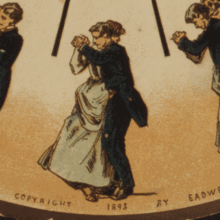|
This page is a sandbox of user:Irene chutta. It serves as a testing spot and page development space for the user and is not an encyclopedia article.
|
 |
Pogonisios is a traditional Greek dance (οrigin: Epirus, Greece) which combines the ancient Greek tradition of the 5-tone non-semitone scale( a sequence of 5 notes, without semitones) with the musical identity of the areas called Pogoni.
Name and etymology edit
The term Pogonisios derives from the Pogoni province of the Ioannina district .It is also called Vasilikos (Basil). The name comes from the homonym song.Its main characteristic is the “Doric”one (also known as “Doricotita”), which stands for simplicity, as well as togetherness.
Composition and rhythm edit
The song accompanying the dance has a unique style which is created by the polyphonic melody in combination with the merry melodic repetition. The Pogonisios song is about happiness, sorrow and anguish, about the heartbreak of immigrants, the bravery concerning matters of the heart.
Τhe best known songs that people dance to this pattern is “Vasilkosthaginostoparathyrisou” and “Gianni mou to mantylisou”.[1]
Steps edit
It is a circular dance at a 2/4 and 4/4 tempo , with the characteristic ups and downs of the torso. The dancers hold hands, the arm is bent to the elbow. It has six steps. Men as well as women dance in superposed circles of two, three and four (double circle, three-circle and four-circle formation), the men form the outer circle whereas women form the inner one, depending on the area. When the dancers form a single circle, the men precede and the women follow, with the exception of the married couple. The women once they are married gain the right to dance first in line, nevertheless, only with her husband. The last man in line and the first woman use a handkerchief to hold hands. The pattern of the dance is Sirtos( or Syrtos) at two steps(συρτοσταδυο) and it is the basis for many similar sirtow dances. It is one of the most basic dance patterns which is encountered in many areas in Greece. Many dances of the Epirus district shift into the Pogonisiospattern.
Variations edit
(place / time spread and differentiation)
Cultural significance edit
(symbolism, occasions)
In popular culture edit
(books, movies, tv series)
Criticism edit
Gallery edit
-
caption
-
caption
See also edit
References edit
- ^ kokkinos pages 10/110
Bibliography edit
Further reading edit
- title.
- title.
External links edit